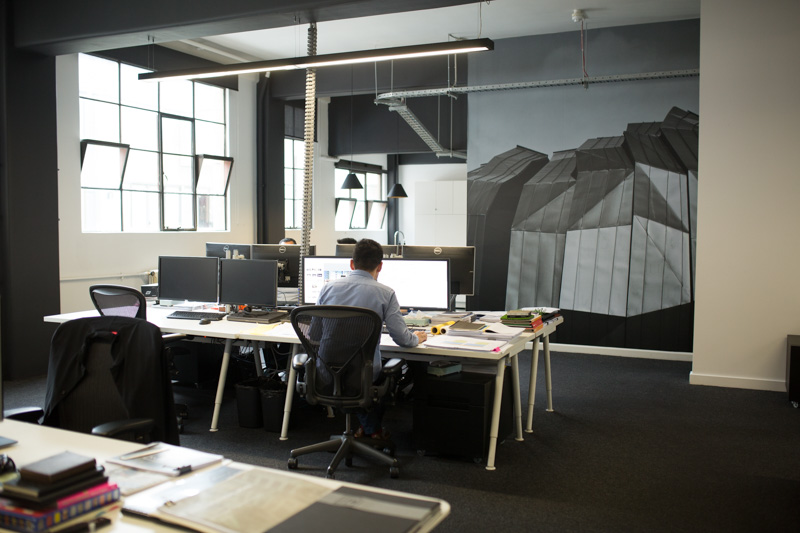
Meet Warren and Mahoney’s managing principal Gavin Kain
Meet Warren and Mahoney’s managing principal Gavin Kain
Share
There are many architects who discover their love for design and the built environment in childhood and Gavin Kain is no exception. But his interests were always diverse and much more far-reaching than architecture alone.
He goes so far as to describe himself as something of a nerd in his passion for reading books about history, geography, society, economics and environmental issues. But certainly architecture was included in that list early on. “Architecture was always a dream,” he recalls. “At about 11 years of age there was a development on the coast in Adelaide and for some reason I had a particular interest in it. I started collecting everything in newspapers and magazines I could find on architecture and worked out what I needed to study to get into university.”
Following his studies and time spent teaching both in Australia and at the University of British Columbia in Vancouver his first job was with Noel Robinson Architects. (The practice now uses the acronym NRA, but adds Collaborative to its title, perhaps to differentiate itself from that other NRA…)
It was here, early in his career, when his other interests came into play, as he first learned the importance of the business side of the discipline. And this was thanks to having Noel Robinson as a mentor. “He made me very aware of the economics,” says Kain. “It’s all very well spending time on design and that’s what we do and how we generate [work], but he made it very clear, as a smaller business at the time, that the two had to align. At times that felt like pressure, but you learned to manage it.”
After two years with Noel Robinson, Kain moved to Woods Bagot, where he found another influential mentor in founding shareholder Andrew Ford. “I worked very closely with him over a 10-year period,” says Kain, “and his business acumen was something I learned a lot from.”
It was during his 16 years with the company that Kain gained an understanding of the overall business, he says. “By that I mean understanding design drivers, clients, economic drivers, your own business drivers and trying to get those to line up.”
Kain believes that a significant reason for Woods Bagot’s growth over the last couple of decades is its business model and specifically its shareholder model. “One of the great successes at Woods Bagot is its planning for the future,” he says. “Around 2004, it started bringing on new, younger shareholders, including me. I had been with Woods Bagot for two or three years and it was a steep learning curve… [but the reason] Woods Bagot managed to expand and grow in such a healthy way was the fact that new shareholders kept getting brought in. New energy, new ideas, new vision to move forward in the business. I think practices that don’t do that can stagnate.”
Becoming a shareholder after just a couple of years at a business sounds like a daunting prospect, but Kain says there were tiers to the shareholding. “It was quite an innovative process. It was not financially prohibitive to start buying shares and then progressively step up in the quantity of shares, which again allows that young energy to come into a business.”
This compares favourably with other models, particularly in the US, he says, where shareholding is tightly held and there’s disincentive to stay with a business. His long tenure at Woods Bagot is testament to his investment in the company.
Last year, however, he decided it was time to make a move. Hitting his mid-40s and needing “time out to reflect on what is effectively going to be the second half of my career”, he briefly considered setting up his own practice.
His friends and colleagues dissuaded him. “I talked about doing smaller projects and house, but people who knew me well, quite a lot of them, went ‘that’s not you, Gavin’,” he says. So he put that idea on the back burner. For now…
What this idea did crystallise in him was the realisation that he thrives on collaboration.
“It was recognising that my experiences are mostly in large buildings and infrastructure and city-based projects. Yes, you can do that in your own practice, but it becomes more of a consultancy, more of an advisory role,” he explains. “I think the recognition that there’s great joy in working with people and sharing ideas rather than necessarily working in isolation was probably the determinant that had me stay working in another practice.”
This brings us to his current role, which began last September. After working closely with Warren and Mahoney while still at Woods Bagot on such projects as the New Zealand International Convention Centre, when Kain was looking for a new professional home, it was a fairly straightforward choice. He says he wasn’t headhunted but, “I had spent several years working with the people, enjoyed their social company and understood what they’re about”.

Inside the Warren and Mahoney office
It also had a similar business structure to Woods Bagot. “It’s not identical… but in a philosophical sense it’s the same model, allowing younger shareholders to enter the business, bringing new energy and the progressive retirement, for want of a better phrase, of more senior shareholders.”
From Warren and Mahoney’s perspective, Kain’s appointment as principal was a very strategic one. Miles Warren founded the multidisciplinary practice in Christchurch, New Zealand in 1955, before going into partnership with Maurice Mahoney in 1958. Sixty years later and now with a staff of 300, there are currently offices in Christchurch, Auckland, Queenstown, Wellington, Tauranga, Sydney and Melbourne.
And it has ambitions to reach further. Kain’s appointment reflects the desire to become a globally significant practice, he says, in particular across the Pacific Rim. It’s his experience and expertise, honed at Woods Bagot, of working across multiple studios that the practice finds invaluable. “I have a particular set of skills around collaboration and how to help facilitate it,” he says. “What I mean by that is there’s a tendency in multi-studio businesses to work in isolation. Whereas the gain is actually through collaborating and recognising that if you’ve got a project in Melbourne, but the skills and experience may be in Auckland, then it’s a natural desire to bring those skills into play. I am at that particular point in my time where I can apply 20 years’ experience of growing a business to a new business that is a little smaller, but has substantial ambitions.”
Regarding those ambitions, Kain says they somewhat mirror those of his former practice. “A bit like the growth of Woods Bagot from Adelaide, New Zealand has always had an outward looking focus as an island, as a small economy. The desire to look to engage with Australia and North America and South America and Japan, it’s a very natural thing.
“That has started to shift into an ambition to be seen as the most significant Pacific Rim design practice,” he adds. “That’s Pacific Rim with New Zealand at the centre, but taking those particular thought processes and values further afield.”
To do that successfully, Kain says it’s imperative that the firm integrate the two tiers of architectural practice. “For me, the business of architecture and the design of architecture are two fundamentally connected elements and there’s too much architecture that ends up in drawers, or in beautiful drawings, whereas it needs to be built and it needs to be implemented, and that involves an understanding of the world.”
Unlikely many in his profession, he doesn’t see the administration side as a necessary evil, but something he enjoys. He also laments the fact that most new architects are unprepared for the realities of the business. “I actually believe that our education is very insular in that it focuses on design for the sake of design, and there are benefits in that, but certainly in the larger-scale world buildings don’t exist in isolation.
“They exist in an economic framework, in a political framework, in a social framework and if you’re not aware of that, the design work is flawed.”
It’s a challenge to get these two sides of the brain talking the same language, with Kain saying, “Usually the classic stereotypical business model is the work winner, the doer and the manager.” He again refers to his mentors for showing him alternatives were possible. “Noel Robinson was certainly an exception in that he could be drawing one moment and talking about finances and resources the next.

Inside the Warren and Mahoney office
“The nice thing about Warren and Mahoney is it’s still small enough to be able to have an overlap between those. It’s an unusual skill set… If you can win work, understand the doing of the work and understand the managing of it, that becomes a powerful position.”
The challenges for Kain in his new role stem include managing and inspiring staff across so many different studios. “I’m a fairly good juggler of tasks, but the reality is that focus is where you get the best results, so when you’re in a workshop with people, focus on the workshop,” he advises.
He learned the importance of giving people your undivided attention a long time ago. “Don’t be wandering off to that challenge around resources in another office. As important as it is, there’s not much you can do about it…
“If people have gathered for a meeting where you’re playing a key role and you’re leaving the room… I’ve done it before, many years ago, and had people say, ‘You do know that you’re totally undermining the whole purpose of the meeting.’
“That’s a lesson learned,” he notes ruefully.
Kain says the division of his time between design and business can vary dramatically. “Ideally, it’s roughly 50/50, but it does change according to needs. You’ve got to be pretty nimble and I think a big part of that is managing priorities and learning to manage stress levels.
“I personally like to deal with all emails on any given day, even if only at a high level. I like when I finish the day, whenever that time is, to be able to know I’ve dealt with those things.”
Stress management, particularly around the amount of travel a role such as Kain’s requires, was another reason he welcomed his new position. While Warren and Mahoney has big ambitions, these remain located in a smaller geographic area than those of Woods Bagot. Kain says he fundamentally enjoys travelling, “but there is a point where you’re spending more time travelling than you are working. And eventually that can catch up with you.”
Three or four hours between New Zealand and Australia makes a big change when you’re used to the 17-hour long haul. Though the man who says he usually has half a dozen books on the go is happy to spend time at airports. He adds that he still loves planning and travelling for pleasure’s sake too. “Where you’re going, what you’re doing, where you’re staying. What buildings are you going to see? I’m fortunate that my interests align with what I’ve managed to do in life.”
This article originally appeared in AR154 – available online and digitally through Zinio.
















